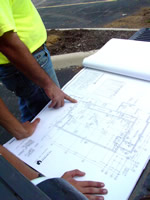There are a number of methods to construct your self build,
these included:
Timber frame Construction
Timber-framed houses are cheaper and quicker to construct compared to conventional builds - that's main point in their favour.
Properly build and maintained they can last in excess of 80 years and probably a lot longer. On the downside , timber-framed buildings are often noisier than their traditional cavity wall counterparts. A masonry cavity wall will always provide better sound insulation because of its greater mass.
Brick & Block Construction
Traditional house building technique used by the vast majority of commercial developers and many self builders. A properly built and maintained property could last 100's of years. Modern brick and block buildings have good insulatory properties and are quieter than timber frame. On the downside they take longer and are more expensive than quicker builds.
Kit houses
The key advantage of a kit house is speed of construction. This reduces the costs of labour and reduces wastage (and site theft). Because of the nature of kit builds you are less at risk from bad weather as much of the prefabrication is completed at the factory.
Key things to check is the quality of the kit as a cheaper kit could mean that bits don't fit which in the end costs more.
Steel Framing
Not a common option for residential homes but very popular in commercial buildings. Benefits include faster build, reduced dry out times and flexibility in project planning.
The downside is that these are not common (yet) and lenders may have issues lending money against them.
Log Cabins
Again Log Cabins can be quick and easy to assemble. The fit
is always perfect, the seal tight and strong. These make them
attractive propositions to self builders. Insulation is good.
However getting the right kit is key.